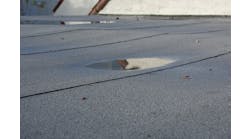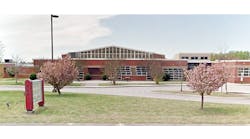Maximizing school resources and managing a shrinking budget — these are two important items affected when a building's roofing system doesn't perform properly. Rather than acting in haste, school and university administrators should do what every teacher tells a student prior to answering any question: think through the research and studies to find the best solution before acting. The same is true when trying to solve a roofing problem.
In planning their course of action, building engineers and school administrators need to consider five elements to help produce a positive outcome:
- Proper diagnosis.
- School advisers.
- Selection of roofing systems.
- Warranties.
- Quality control.
Assess conditions
Before ordering that new roof or caulking everything in sight, administrators need to carry out a vital first step: assess the roof's condition and determine which corrective action is needed. Often, an untrained eye will choose a costly repair that is either overkill or just a stop-gap fix. Rather than jump into a repair, facility managers first should do the research.
Although a custodial team may be able to identify the signs (or symptoms) of a leak, a trained professional, such as a specialty engineer, not only can find the cause of the leak, but also identify deficiencies that could lead to future ones (see the sidebar, "Simple steps to extend the service life of existing roofs"). Assessing existing conditions enables education institutions to choose the proper method of fixing the problem, whether it is a repair or, in the worst case, total replacement.
Reviewing the facts can save thousands of dollars and get the job done right the first time. In many instances, the life of the roof can be extended by three to five years with minor repair and refurbishment.
Selecting partners
Do the research when selecting a partner. When people have the flu, they don't go to an accountant. Selecting a professional who is totally versed in repairing and replacing institutional roofing systems is essential. A design professional will be able to properly identify and specify appropriate performance criteria for the repairs or replacement.
The architecture/engineering firm a school hires should be familiar with the geographic location and specific building codes.
Many firms specialize in school construction for new and re-roofing projects. A firm that specializes in this work may cost more, but the additional cost is worthwhile if it leads to a properly specified and installed product without the extras and change orders that inexperienced contractors often submit.
All materials not equal
For repairs, many products are available. Within each single-ply, modified bitumen or spray polyurethane foam category (among many products), additional product types are available with varying performance characteristics and installation requirements, ranging from mechanically attached and fully adhered to spot-applied and self-adhered.
Not all materials are suitable for all projects. In fact, a single project may have different areas and substrates that benefit from different materials. Again, do the research to find the best solution.
The Internet is a valuable tool for research to verify the materials recommended or specified by the design professional and contractor. Also, review a manufacturer's product data sheets and physical properties to confirm that a product is right for your project.
For example, schools situated in the South may be concerned about energy savings. Hence, white or light-colored roofing makes sense to reduce surface and interior temperature, and to lower air-conditioning expenses.
If a rooftop will have a lot of activity, the choice of material becomes paramount. In this example, unreinforced EPDM would not be an ideal solution.
The warranty/guarantee
A big misconception is that having a roofing warranty is protection against problems. Roofing warranties are written by attorneys retained by manufacturers, and their language is such that the terms and conditions benefit them. So it is important to understand what the warranty covers.
Warranties run from five to 20 years, and requirements often get stricter as terms get longer. Typical coverages:
-
Full system warranty
Material and labor are covered to repair or replace damaged areas because of defective material or improper installation. They can be of "No Dollar Limit" or "Limited to Original Installation Cost."
-
Limited warranty
Material only, which means a manufacturer will supply materials to replace defective materials at no cost. These warranties generally are limited to the original cost of material, which is important to know when materials need to be replaced after 10 years and the institution has to make up the price difference.
In some cases, repairs carried out by a staff member — and not a contractor — may void the warranty. Check the fine print before acting.
Keep in mind that the better warranties are not free. The more protection you want, the more money they will cost. Generally, warranty costs range from $0.10 to $0.25 per square foot.
Review the proposed warranty as specified and upon completion of the project to ensure the warranty provided by the manufacturer is as specified. Review the language stipulating wind-speed coverage as it can range from 33 to 100 mph. For specific wording regarding a warranty, ask the manufacturer, because many will attach a separate rider to the warranty to accommodate an owner's request.
Management and monitoring
A traditional bid system can produce expensive and poor work without proper monitoring by a third party. For any repair or replacement project, adequate inspection services are critical to the outcome.
As one example, within the construction market, competition is so tight that many contractors are forced to bid projects at levels at or just above the break-even point. As a result, without monitoring, contractors can have a school at its mercy, potentially hitting the school with unnecessary change orders at elevated prices to make a profit after bidding low on a project.
Additionally, contractors who bid the lowest can't always recruit and pay for the most skilled workers. Although the majority of the contractors do not intend to do a bad job, they cannot watch every worker install a product. As such, experience shows that when problems occur, nearly 66 percent of the problems are related to workmanship. Often, workers simply don't follow proper industry or manufacturer guidelines.
Contracting with a firm to provide full-time supervision does not guarantee that there will be no problems, but it does eliminate many issues, and it provides one person on the roof who is responsible for the daily construction activities.
Read the sidebar, "Simple steps to extend the service life of existing roofs," to this article.
Baker, PE, is president and principal of IBA Consultants, a building envelope consulting firm with eight offices nationwide. He can be reached at (888)550-4422 or [email protected]. Keane, RRC, is a senior consultant with the firm. He can be reached at (888)550-4422 or [email protected].
Notable
33 to 100
In miles per hour, typical wind coverage range on a roofing warranty.
Simple steps to extend the service life of existing roofs
Every spring and fall, the custodial staff should check, and correct where possible, the following:
-
Roof access, which should be limited to only those needing access. In addition, a sign in/out log should be created to monitor roof traffic.
-
Protective walkways are in appropriate traffic areas.
-
Drains, scuppers, gutters and downspouts should be cleared of debris and checked to ensure they are functioning properly.
-
All accumulated debris, foliage or garbage should be removed.
In addition, inspect for and document the following potential deficiencies:
-
Ponding water/inadequate slope to drain.
Ponding water will reduce the service life of a roofing system and could void any warranties.
-
Soft spots and depressions
These can be a sign of collapsed insulation, generally because of either construction traffic or moisture saturation.
-
Blisters and bubbles
Blistering and delamination of roofing plies can be a sign of moisture intrusion, wind damage or poor installation. Administrators should notify the membrane manufacturer immediately in writing when they discover any areas of observed or suspected delamination.
-
Seam integrity
Where the roof system overlaps or seam areas can be visually inspected, any suspected voids or openings should be documented and the manufacturer contacted for repair.
-
Flashings and penetrations
Inspect flashings and penetrations for proper membrane adhesion. Inspect caulk sealant for signs of weathering. Inspect penetration pockets (pitch pans) to verify that the sealant inside the pocket has not shrunk and led to cracks that allow water intrusion.
-
Metal and stone copings (where they exist)
Many leaks blamed on roofing materials actually are the result of water infiltration through joints of metal or stone coping systems. An inspection should be conducted to make sure coping systems remain properly in place; wind and building movement sometimes can displace these items and lead to cracks and water infiltration.


